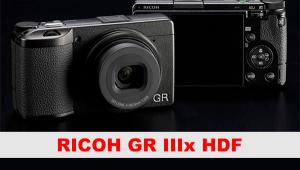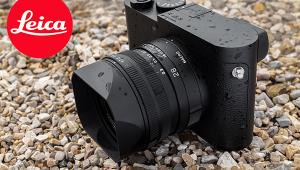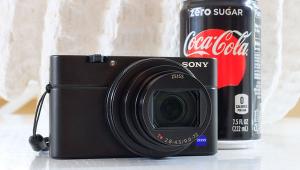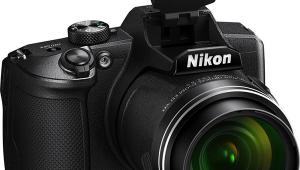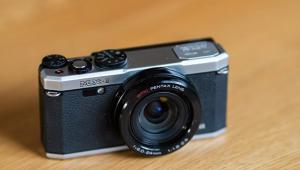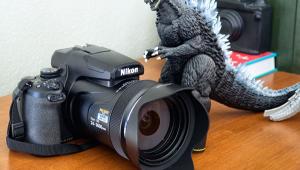Sony Cyber-shot RX10 IV Review: Premium Superzoom Camera Offers Faster AF & 24FPS Burst Shooting
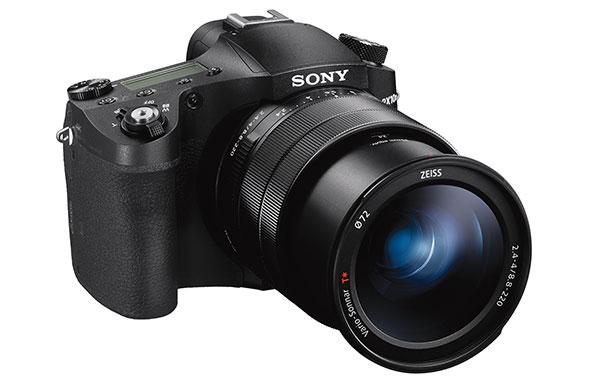
Integral zoom lens cameras are often referred to as “bridge” cameras: the idea being that they bridge the gap between compact and DSLR models. If there’s a bridge connection here it’s in the rather incredible zoom range of the Sony Cyber-shot RX10 IV ($1,700, retail price) that spans the far shores of 24-600mm equivalency.
While a camera/lens combo of this capability is necessarily larger than a DSLR body alone, and at first glance may seem like a candidate for shaky shots when zooming to the longer focal lengths, the RX10 IV takes full advantage of Sony’s built-in Optical SteadyShot image stabilization system (4.5 EV shutter speeds) along with any corrective optical adjustments applied to the various focal lengths via the BIONZ X image processor.
Both dust- and moisture-resistant, the Sony RX10 IV superzoom camera contains a 20.1MP one-inch-type stacked phase-detection AF Exmor RS CMOS sensor with a DRAM chip. There are two key operative phrases here that speak to its overall size and image quality: the one-inch sensor allows for a “smaller” camera with such a long zoom range, while phase detection speaks to the improved autofocus (AF) performance—claimed to be an incredible AF response time of 0.03 seconds—critical when you zoom far into the reaches, and when capturing action images. (Sony’s previous model, the RX10 III, used contrast-detection-based AF, which was noticeably slow.)

The Sony RX10 IV is not a camera you can slip into your pocket, being 5.25x3.75x5.12 inches in size and weighing in at 2 pounds, 6.7 ounces with card and battery. But for travelers, landscape and sports photographers, and enthusiasts who like to have one camera/lens combo that covers just about every imaging contingency, it might just fill the bill. I recently had an opportunity to test the camera while on a trip to Spain and was eager to put it through its paces.
Specs & Features
The obvious place to start is with the lens, a Zeiss Vario-Sonnar T*, which contains six aspheric elements: it’s a comparatively fast 25x zoom that has an f/2.4 max aperture and only drops to f/4 when you begin to zoom out to the longer ranges. When working in standard format and using AF, the lens can focus as close as 1.2 inches to infinity at the 24mm setting and 28 inches to infinity at the 600mm setting; a seeming anomaly is that when shooting at 250mm the minimum focusing distance is more like 55 inches.
The specs on this seemed confusing, so I reached out to Sony to get an explanation: their reply was that constructing a lens such as this required this midstream, if you will, focusing distance change in order to make it a more reasonable size, and that this was not uncommon among lenses of this focal length range.

The large and bright XGA OLED EVF provides 100% field of view and contains 2.35 million dots with a wide-range diopter and five-step brightness control, while the three-inch tiltable LCD contains 1.44 million dots. The screen does not swing side to side and does not enable folding into the body to protect it. The view switches automatically when you move from the EVF to the monitor, and vice versa.
Focusing modes include single and continuous, as well as manual. Focusing areas are legion and selectable via touchscreen and “quick” menu control, with 315 points in phase-detection AF and 25 in contrast-detection AF. You can choose, for example, center, flexible spot (with expandable available as well), and lock on AF. There is a touchscreen option for selecting a focusing point.
The Sony RX10 IV’s continuous shooting mode can be set at up to 24 frames per second (fps) for a 10-second burst, impressive numbers that mean you won’t miss the (automated) decisive moment. (The previous camera could shoot up to 14 fps bursts.) You can also “frame grab” from the RX10 IV’s 4K video capability, yielding an 8MB still from video sequences. There are the three standard metering pattern modes, plus a highlight compensation mode.

There are numerous image control options, including contrast, saturation, and SRGB and Adobe RGB color space options, plus myriad “picture effects” and “creative styles” that allow you to play with many different “looks.” These include intriguing effects such as Retro Photo, HDR Painting, Panorama, Posterization, and the like. Plus there are the requisite AV, TV, Program, and Manual exposure modes.
The fastest mechanical (leaf type, in lens) shutter speed available is 1/2000 second: there’s also a selectable (via the menu) electronic shutter that, thanks to the stacked CMOS sensor with its very fast readout speed, allows shutter speeds as fast as 1/32,000 second. The slowest speed on Auto is four seconds, while in Bulb, TV, and AV it’s 30 seconds.
Note that the “native” ISO range is 100 to 12,800, plus a “push” to 25,600 when you enable Multi-Frame NR (note that video is limited to ISO 12,800). As to connectivity, there are numerous input and output terminals, including a microphone mini-jack, and Wi-Fi, NFC, and Bluetooth connectivity.


Last but not least is the Sony RX10 IV’s impressive AF acquisition speed of 0.03 seconds, and while I did not have the tools to measure this, the camera fairly zipped into focus when in the field. As with use of all long-range zoom lenses, be careful to lock onto the nearest object within the frame. I only say this because many folks are not used to working with this long a focal length optic and proper focusing point placement is critical to success.
Hands On
As formidable as the zoom range, the Sony RX10 IV itself is large in hand, with a host of buttons, dials, and menu options. A large grip protrudes forward on the right-hand side and the entire body is covered with a good “grippy” surface.
Although the camera comes with a basic instruction manual that can get you started, you will need the Help Guide to really get into the many options and functions the RX10 IV provides. This is available as a download only, which you will need to read and practice with before even thinking of going out into the field. I am not a fan of this method of communication, particularly because it is of no use when you are out on a shoot unless you take a tablet as your companion, or want to print out the booklet and carry a binder.
To navigate the menus you choose the “set,” including still, movie, connectivity, playback, and custom setups. To give you an idea of how deep the menu goes, the still settings are 14 layers deep and the movie mode is four. However, if you are in the Camera 2 settings, which start out with the four movie setups, you get six more (to me, hidden) camera and function setups as well, including SteadyShot enabling (which I encourage you to keep on), zoom functions, and more.

It takes some practice to move through the menus but basically it’s done by turning the knurled control ring on the back in combination with a deft touch of the outer edges of that same ring to make selections. There is a kind of quick menu, which I accessed via the “Fn” button on the camera back and then I scrolled and chose via the back knurled ring. This came in quite handy in the field.
The lens itself, the star of the show, measures about 2.5 inches long when at rest (24mm) and a good six inches when fully zoomed (600mm). If you count the (included) “tulip” lens hood, a must when shooting in the field, you can add 1.5 inches to the overall length. There are some “digital zoom” capabilities (essentially cropping to attain an even longer focal length effect) but I don’t recommend them unless absolutely necessary. There’s an aperture “click” switch that allows you to choose between click stops (1/3 increments between stops) or a smooth transition; a focus hold button on the right of the barrel; and a focus delimiter switch, used to limit focus search to within 10 feet to infinity, which makes for faster AF on longer distance subjects.
One more item of interest: the battery charger. There isn’t one, at least not the separate charger setup/wall plug-in I am accustomed to. Rather, there is a USB-type setup that is akin to a smartphone charger that plugs directly into the camera. You can use a car charger, etc., so there are some practical convenience factors here. And yes, you can buy an optional Sony dedicated battery pack and battery. This, for me, turned out OK, but judging from the chatter on the web, this approach gets mixed reviews.
In the Field
Please see the images and accompanying captions for comments on camera usage and results. After acquainting myself with the various and numerous options and parameter settings I came to a fairly easy way of working with the Sony RX10 IV.
First, I set up my Auto ISO to maintain a minimum shutter speed of 1/60 second and a max ISO of 3200. For street work I worked with Program exposure mode, working with the Shift to alter aperture/shutter speed combinations. I changed aperture via the click stops on the lens. I set up my main attributes using the “Fn” button quick mode and assigned the drive mode to the C1 button on the top.
I worked with AWB (Auto White Balance) for interiors and daylight to outdoor images. I made some use of the Picture Effects (available via the “quick menu”) and admit to getting hooked on the options. I zoomed using the lens ring, although at times used the automated zoom that surrounds the shutter button for a quick leap into the longer ranges.

I found the EVF to be very sharp and clear and an excellent performer in low light. The LCD offers many display options, although I like a clear screen when composing, and was very helpful in swapping settings as I worked.
Conclusion
In all, the Sony Cyber-shot RX10 IV is as complicated (or, if you will, fully featured) as you want it to be, or as simple as you like. Most folks will opt for the latter option, or somewhere in between. Getting acquainted with the various routes through the very rich menu took some time, but after a while I found it to be a great traveling companion that responded to every picture possibility. In fact, this is a superzoom camera I would strongly consider as my main workhorse for candid street and travel work in the future.
Without a doubt, this is a camera you can customize to the nth degree to fully explore your imaging effects and options. While it’s best to start out slowly to fully learn just what the Sony RX10 IV offers, you might find, as I did, that this rather remarkable camera will reward you with a flexibility and range of options that few other integral lens “bridge” cameras can provide.
(Editor's Note: Read our review of the new 125x Nikon P1000 superzoom camera here.)
- Log in or register to post comments
